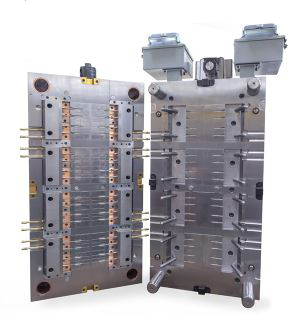Hot runner molding systems #4
Focus on gate design— valve gate systems

Valve gate systems are recommended for hot runner systems used to mold Eastman Tritan™ copolyester. Advantages compared with other hot melt delivery systems include:
• The melt channel is externally heated.
• Mechanical shutoff allows better gate vestige control.
• The gate size is generally large.
• The valve pin is retracted during the filling process, resulting in a less
obstructed flow. The end result is less shear heating and pressure drop
when processing Tritan.
• Mechanical shutoff allows better gate vestige control.
• The gate size is generally large.
• The valve pin is retracted during the filling process, resulting in a less
obstructed flow. The end result is less shear heating and pressure drop
when processing Tritan.
Early collaboration of all stakeholders to ensure efficient hot runner design and proper heat management of the mold and the mold cavity will pay lasting dividends when molding Tritan.
Valve gate considerations for your hot runner mold
Gate size and aesthetics
Special care should be taken to ensure the valve pin seats well to ensure good contact. Even with adequate cooling and good contact, there are limitations with gate size. Gate sizes 3.0 mm (0.125 in.) and below generally result in the best aesthetics. Gates larger than this are often difficult to cool and result in poor gate aesthetics due to sticking.
Another factor affecting gate area aesthetics is crystallization. An Eastman technical service representative can help you determine if this will be an issue.
Cooling at the gate
Drooling, sticking, and stringing may occur if the gate does not cool properly. Steel that is directly heated as part of the hot drop should not contact the part directly; it should be insulated from the cooled portion of the mold. An independent cooling circuit in close proximity is often suggested.
(See Part 2 of this series for information about mold heating and cooling and recommended temperature guidelines for Tritan.)
Another viable solution for temperature control is a water-jacketed insert. These are sometimes custom fabricated but are also available as standard items from some manufacturers. They usually result in a witness line around the gate, which may need to be considered.
The mold should be designed so that heat is quickly removed from the gate. This is best accomplished by the gate orifice being an integral part of the cavity steel, rather than the hot runner system being an insert.
When the gate is in the cavity, cooling channels can be incorporated to provide the cooling needed for the cavity in the gate area.
Plumbing this circuit independent from other cavity cooling channels can be beneficial, as separate water temperature control can be used to optimize molding performance in both the gate area and the mold cavity.
For more information about hot runners, download the Eastman Tritan™ copolyester Processing Guide. Or talk with your Eastman technical service representative.
In Part 5 of our hot runner series, we’ll look at a hot runner success story molding Tritan.






 Close
Close


